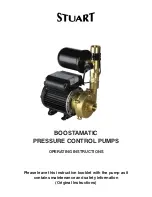
11
4. Connection
4.1 Connecting fluid piping
1) Connect a flow valve and a drain valve to the fluid discharge port of the pump.
2) Connect a valve for maintenance to the fluid suction intake port of the pump.
3) Connect a hose to the valve on the suction-port side and the valve of the discharge-port side of the
pump.
4) Connect a hose on the suction-side intake and the discharge-port side to the respective vessels.
CAUTION
• Use a flexible hose to absorb pump vibration, and ground the hose.
• Make sure that there will be no external force on any connection part of the pump. Be
especially careful not to have the pump support part of the weight of the hose and the piping.
• Use a sturdy hose that will not collapse under the strong suction of the pump. Also, make
sure the hose is of more than sufficient pressure rating.
• Use a hose of a diameter the same as or larger than the pump's ports. If you use a hose of
smaller diameter, the pump's performance will be adversely affected, and it may even
malfunction.
• When pumping a fluid that contains slurry, verify that the particle size is below the slurry
limitation (see [10.1 Main specifications]). If it exceeds the limitation of slurries indicated in
the main specifications, attach a strainer to the pump to stop larger particles. Otherwise,
such particles may cause a malfunction.
• If, depending upon the place of pump installation, the
volume of the pumped fluid changes drastically, install a
relief valve on the discharge side, and bring the pressure
down below the maximum permissible value. If, owing to
a change in the volume of fluid, the pressure inside the
pump exceeds the maximum permissible pressure, it
may cause damage.
• Keep a vessel below the relief valve to catch any
drain off.
• When testing piping for leakage, do NOT apply pressure to the pump's inlet and outlet sides
with compressed air from outside. It may cause abnormal breakage to the diaphragm or the
switching portion. When testing the piping, either install a valve between the pump's suction
inlet and the discharge outlet and piping, or disconnect the pump from the piping and install
plugs so that there will be no pressure from outside.
• In our product inspection, clean water is used. To prevent mixture of dirty water into the
fluid to be pumped, clean the inside of the pump before finishing installation work.
• When installing a standby pump or two pumps in parallel from, be sure to provide a valve on
each of the IN and OUT sides and perform pump switching by using the liquid material
valve. If the valve of the stop-side pump is open, the diaphragm will be inverted by the
discharge pressure of the operating-side pump, resulting in damage in an early stage.
Fig.4.2
Fig.4.1
Summary of Contents for NDP-P20 Series
Page 2: ......
Page 3: ......
Page 4: ......
Page 25: ...21 NDP P20BP FLANGE TYPE 10 2 2 NDP P25 series NDP P25BA NDP P25BS...
Page 26: ...22 NDP P25BP THREAD TYPE NDP P25BP FLANGE TYPE...
Page 33: ......
















































